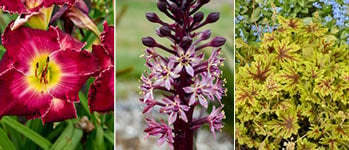Perennials from Seed - Gardening Advice
Q: Is there a trick to growing perennials from seed? I’m intimidated by the process. Can you help get me started? - Sam Ferrara, Merrick, N.Y.
A: Watching seedlings emerge from the soil is one of my greatest thrills as a gardener. And growing herbaceous perennials from seed is one of gardening’s great economies. In contrast to the rigamarole of starting annual flowers and vegetables indoors, the routine with perennials is simple. In fact, most perennials prefer to get their start outdoors because they need some exposure to cold, moist conditions — a process known as stratification — to ready them for spring sprouting. This is nature’s way of keeping seeds from emerging prematurely during a warm spell in late autumn or winter. Over the years, I’ve had my successes and failures, but I’ve found that the key is sowing fresh, viable seeds. Perennial seeds should be kept dry and cool (35º to 50º F). So I store them (along with moisture-absorbing silica gel that I buy at a hobby shop) in Tupperware in the refrigerator to prepare for winter sowing.
Perennial seeds are usually ready to sow as is, but those with fuzz or chaff (husks) should be stripped clean. Soak hard-coated seeds such as lupines, baptisia, and thermopsis in scalding-hot water for a few hours; once they sink, they are ready to sow. (Nicking all the seeds with a file helps them absorb some water.) Members of the Ranunculaceae family — delphiniums, peonies, anemones, hellebores, and pasqueflowers — should be sown as soon as the seeds ripen after flowering, but I sow all other perennials in January and February in 4-inch plastic or clay pots filled with a moistened, sterile, peat-based potting soil mixed with an equal amount of coarse washed builder’s sand. After pressing the seeds into the soil, I shake a thin (about 1/16th inch) layer of aquarium grit on top, as a water-conserving and temperature-moderating mulch. Watering from below, I know the soil is fully moistened when the grit turns dark. Then I put them out in a dependably cold and shady area, such as the north side of a building. If it snows, I shovel the white stuff on top. In dry climates, you may need to water them a few times before spring. In rainy climates, you’ll need to cover them with a pane of glass, or the seeds may rot in the waterlogged soil. Otherwise, ignore the seeds until they sprout in spring.
Some species germinate as soon as the temperature gets above 50ºF; others wait until it’s really warm. Some will appear sporadically over a year’s time. A few will never come up, but don’t take it personally. Those that do appear can be moved into their own pots in early summer and planted in the garden come autumn.





